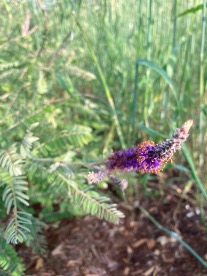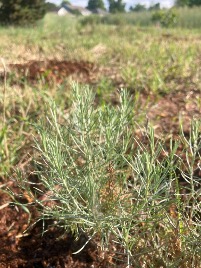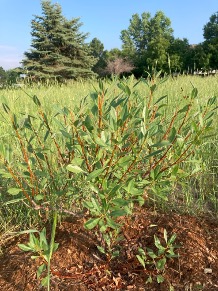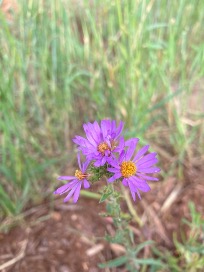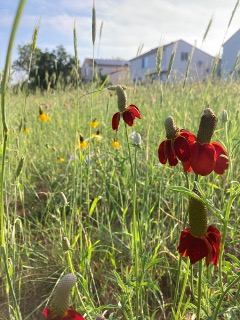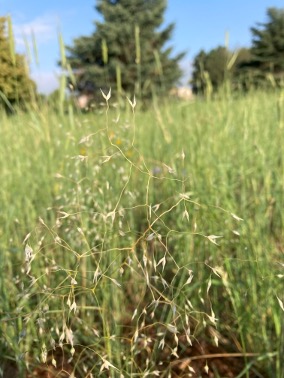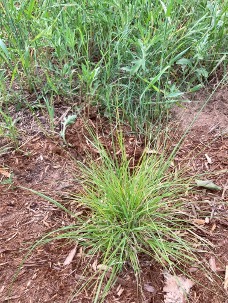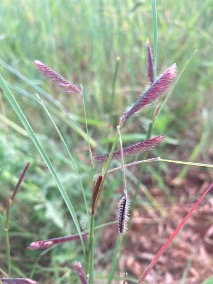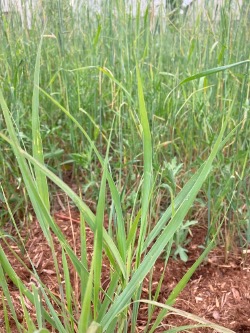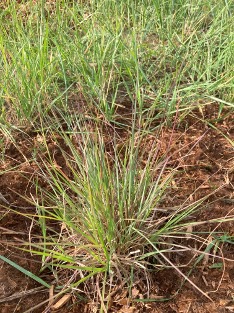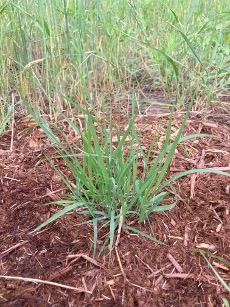In Spring 2023, the High Line Canal Conservancy planted over 170 native prairie plants along the Canal with the support of volunteers! The Conservancy collaborated with Denver Parks and Recreation to implement this prairie planting pilot on the trail shoulder between Marrama Park and the Canal trail in Green Valley Ranch. The project includes a small irrigation extension from Marrama Park which will provide establishment watering for native grasses, wildflowers, and shrubs. These plants will increase the diversity of the corridor’s plant community and provide valuable habitat for pollinators and other wildlife.
Much of the Canal corridor through Green Valley Ranch is dominated by cultivated rye (Secale cereale, also called cereal rye), an annual grass native to Eurasia that was brought to the United States as an agricultural grain. While cultivated rye can be used to make rye flour, brew beer and feed livestock, it does not provide high habitat value for our region’s wildlife. This restoration project aims to increase the biodiversity of the Canal corridor in Green Valley Ranch by planting a variety of native grasses, forbs and shrubs in the rye-dominated trail shoulder. These prairie plants have coevolved with Colorado’s pollinators and animals over millennia and provide critical shelter and food for our urban wildlife.
The species included in the pilot planting are all native to the Colorado plains and were selected for their ability to thrive in the Canal’s environment. These native plants are uniquely adapted to Colorado’s climatic and environmental conditions and are able to survive with very limited water once established. The mix of shrubs, forbs and grasses planted in this pilot project will provide nesting sites for native bees, nectar for butterflies and berries for migrating songbirds.
Native plants and ecosystems are also important to the Indigenous people of Colorado. The Conservancy consulted with Spirit of the Sun-an Indigenous-led nonprofit working to empower Native communities through farming, education and rematriation-to ensure the planting palette prioritized ethnobotanical species of cultural significance, such as Western Sand Cherry, Three-leaf Sumac, Indian Ricegrass, and Yarrow.
Prairie Planting Palette
The prairie planting palette prioritizes native species that can thrive in low water, full sun conditions. The palette was also designed to include plants with a range of mature sizes and a range of flowering/fruiting periods so that a variety of wildlife can benefit from the planting throughout the year.
SHRUBS
Leadplant (Amorpha canescens)
- Flower: Violet-purple, mid to late summer
- Fruit: Legume
- Mature size: about 3’ by 3’
- Roots can grow 4’ or deeper
Dwarf Rabbitbrush (Ericameria nauseosa ssp. nauseosa)
- Flower: Yellow, mid-to late summer
- Leaf: Linear, bluish-gray
- Mature size: about 1’ tall
- Attracts native bees
Western Sand Cherry (Prunus pumila var. besseyi)
- Flower: White, late spring
- Fruit: Purplish-black drupe
- Mature size: up to 6’ tall
- Provides fruit for birds and other wildlife
Three-leaf Sumac (Rhus trilobata)
- Flower: Yellow, early spring
- Fruit: red drupe
- Mature size: 4ft tall and up to 10ft wide
- Provides nesting materials for native bees
FORBS
Yarrow (Achillea millefolium)
- Flower: White to apricot to yellow cluster
- Leaf: fern-like
- Mature size: about 2’ tall
- Fragrant foliage
Bigelow’s Tansyaster (Machaeranthera bigelovii)
- Flower: Violet, early summer
- Leaf: Slender, sticky
- Mature size: about 2’ tall
- Attracts native pollinators
Prairie Coneflower (Ratibida columnifera)
- Flower: Yellow to red, summer
- Leaf: Linear, narrowly divided
- Mature size: about 2’ tall
- Provides nectar for pollinators and seeds for birds
Spiderwort (Tradescantia occidentalis)
- Flower: Blue to purple, early summer
- Leaf: Reed-like
- Mature size: about 1.5’ tall
- Attracts native pollinators
GRASSES
Indian Ricegrass (Achnatherum hymenoides)
- Inflorescence: Open, airy panicles
- Leaf: Narrow, arching
- Mature size: about 2’ tall
- Seeds eaten by birds and small mammals
Sideoats Grama (Bouteloua curtipendula)
- Inflorescence: On one side of stem only
- Leaf: Linear, flat
- Mature size: about 2’ tall
- Provides nesting structure for native bees
Blue Grama (Bouteloua gracilis)
- Inflorescence: One-sided spike
- Leaf: linear, flat
- Mature size: about 1’ tall
- Host plant for skipper larvae
Switchgrass (Panicum virgatum)
- Inflorescence: Airy panicles
- Leaf: Vertical, linear
- Mature size: about 4’ tall
- Essential larval host for banded skippers and satyrs
Little Bluestem (Schizachyrium scoparium)
- Inflorescence: Slivery-white, airy
- Leaf: Upright, gray-blue
- Mature size: about 2’ tall
- Provides nesting materials for native bees
Indian Grass (Sorghastrum nutans)
- Inflorescence: Long spikes
- Leaf: Arching, linear
- Mature size: about 4’ tall
- Attracts butterflies and birds

